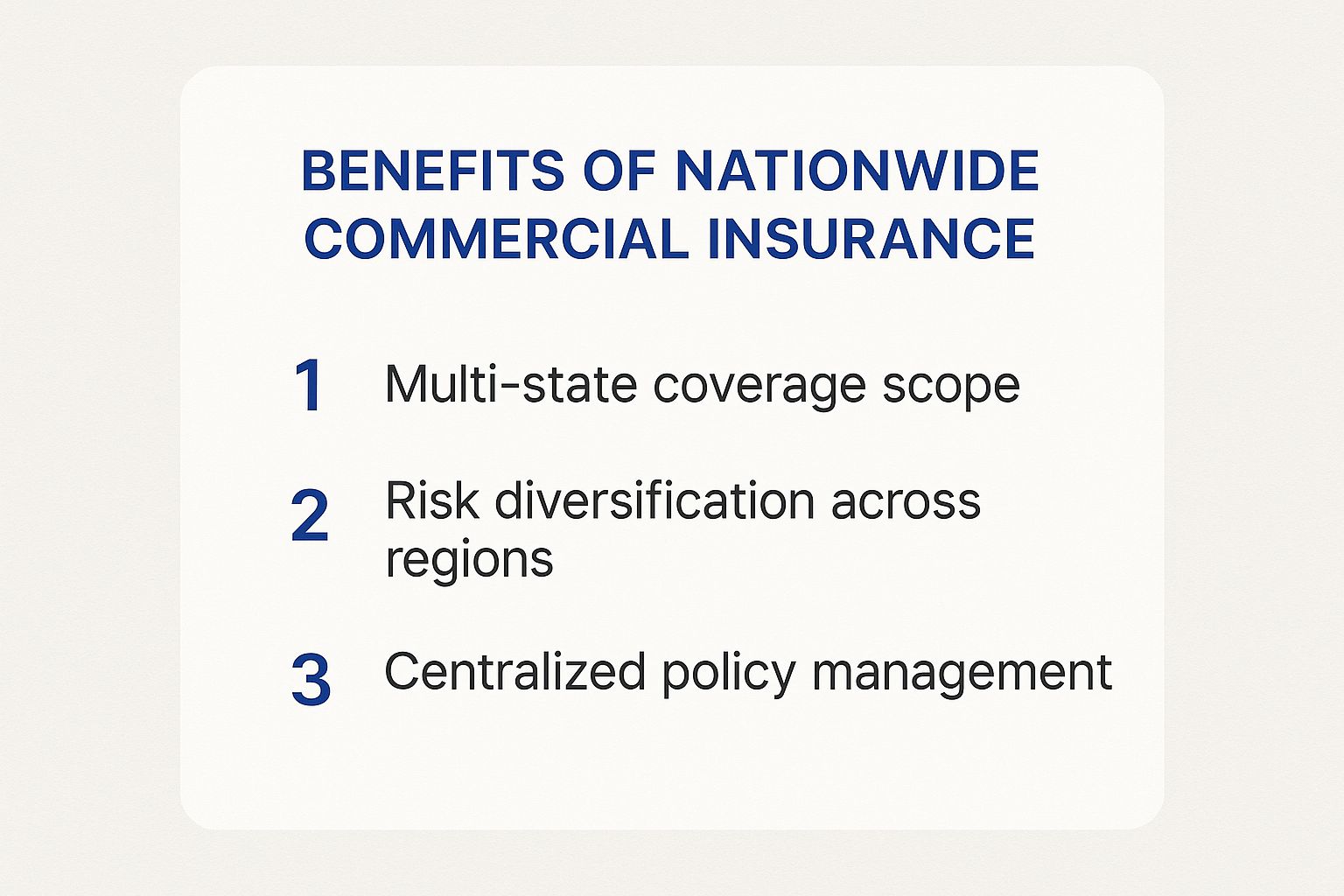For any business operating across state lines, commercial insurance nationwide is not a commodity—it is a strategic asset. A well-structured insurance portfolio is a critical component of operational resilience, essential for any company with a national footprint. This guide provides actionable insights for risk managers, brokers, and underwriters on how to build and maintain a robust nationwide insurance program.
Building Your Nationwide Insurance Foundation

Image
Effective risk management leaders—brokers, underwriters, and risk managers—view insurance as a core operational investment, not a line-item expense. It is the foundational step toward building a resilient national enterprise.
An insurance portfolio must be assembled with architectural logic. Each policy is a load-bearing component, critical to the structure's stability and future viability. The objective is not merely to purchase policies but to design a comprehensive defense system engineered to withstand multi-state operational risks. A single coverage gap in one jurisdiction can compromise the entire organization.
An Architectural Analogy for Coverage
To manage nationwide risk effectively, an architectural analogy is useful. A robust insurance program is essential for any business operating nationally, as risks and regulations change dramatically across state lines.
- General Liability is the Foundation: This is the base layer of protection. It serves as the primary defense against third-party claims for bodily injury or property damage, providing fundamental stability across all jurisdictions, from New York to California.
- Workers' Compensation is the Safety Framework: This component represents regulatory compliance and employee protection—analogous to fire codes and safety systems. It ensures adherence to legal obligations to employees, which is critical given the significant variations in state-level mandates.
- Commercial Property is the Structure: This policy protects physical assets, including buildings, equipment, and inventory. For a business with a national presence, this means safeguarding every warehouse, office, and storefront from regional threats like fire, theft, or natural disasters.
A robust commercial insurance strategy for a nationwide business is not about securing the lowest premium. It is about constructing a portfolio that mirrors the operational footprint, anticipates regional risks, and ensures no single event can threaten the entire enterprise.
These layers interlock to create a formidable defense. Neglecting one component is equivalent to leaving a section of your operational headquarters exposed to catastrophic loss.
By strategically structuring your commercial insurance nationwide, you ensure your business has the integrity to not only survive the varied risks of a national market but to thrive within it. This is a cornerstone of responsible, sustainable growth.
Understanding Core Commercial Insurance Policies
Protecting a business that operates across state lines requires a technical understanding of how core policies function in a multi-jurisdictional environment. A sound commercial insurance nationwide program is built on four foundational pillars, each designed to address specific, high-stakes liabilities that can arise anywhere the business operates.
These policies are designed to function as an integrated system, creating a comprehensive safety net. A gap in one area can expose the company to significant financial and legal liabilities. Therefore, risk managers, brokers, and underwriters must have a firm grasp of each component's function.
The Four Pillars of Nationwide Business Coverage
These four policies form the structural core of a company’s risk management framework. Each serves a distinct purpose, and when combined, they provide a powerful defense against the most common threats a national business faces.
Whether it involves a customer injury in a Texas showroom or a fleet vehicle accident on a Florida highway, these coverages provide the first line of financial defense.
- General Liability Insurance: This is the primary shield against third-party claims, covering bodily injury, property damage, and advertising injury for which the business is legally responsible. For instance, if a client slips and falls at a California office, this policy would cover their medical expenses and associated legal defense costs.
- Commercial Property Insurance: This policy protects physical assets, including owned or leased buildings, inventory, equipment, and furnishings. It provides coverage for perils such as fire, theft, or severe weather. A major fire at a primary warehouse in Illinois could be financially catastrophic without this protection.
This image highlights the critical advantages of an integrated nationwide insurance strategy.

Image
A cohesive approach provides multi-state scope, risk diversification, and simplified administration—all significant advantages for a business operating on a national scale.
The table below provides a concise summary of what each fundamental policy protects against, along with a practical scenario.
Core Commercial Insurance Policies at a Glance
| Coverage Type | What It Protects | Real-World Example |
|---|---|---|
| General Liability | Third-party claims of injury or property damage. | A customer slips on a wet floor in your retail store and sues for medical expenses. |
| Commercial Property | Your business's physical assets (building, inventory, equipment). | A fire breaks out in your office, destroying computers, furniture, and documents. |
| Workers' Compensation | Employee on-the-job injuries and illnesses. | A warehouse employee injures their back while lifting a heavy box. |
| Commercial Auto | Vehicles used for business operations. | A delivery driver causes a multi-car accident while making a drop-off. |
While these core policies form the bedrock of a resilient business, navigating state-specific mandates for certain coverages presents a significant challenge.
Navigating State-Specific Mandates
While General Liability and Commercial Property are fundamental nationwide, Workers' Compensation and Commercial Auto are subject to a complex patchwork of state-level requirements. This is a primary area where nationwide businesses encounter compliance issues.
Workers' Compensation Insurance provides benefits for employees who are injured or become ill due to their job. This coverage is mandatory in nearly every state, but the regulations are not uniform. Texas, for example, is unique in allowing most private employers to opt out of the state system. Conversely, states like Florida and New York have stringent requirements and impose severe penalties for non-compliance. An employee injury in one state will trigger a different legal and claims process than the same injury in another.
Commercial Auto Insurance is required for any vehicle used for business purposes. Minimum liability limits are a key area of state-by-state variation. Coverage limits sufficient in one state may be dangerously inadequate to cover a serious accident in another, exposing the company to significant out-of-pocket costs.
For brokers and risk managers, the critical task is not just securing these policies but ensuring they are correctly calibrated to the specific legal and risk environment of every state in which the business operates. A one-size-fits-all approach is a recipe for failure.
The market for these policies is also dynamic. The U.S. commercial insurance sector posted a significant underwriting gain of $9.3 billion in early 2024, a notable turnaround from the $8.5 billion loss recorded in the same period of 2023. This profitability, driven by strong premium growth and moderating inflation, indicates a healthier market for carriers, which can directly affect coverage availability and pricing. For a deeper analysis of these market dynamics, refer to the 2025 Commercial Insurance Market Outlook.
Insuring Against Modern Business Threats

Image
While foundational policies like general liability and property insurance are essential, they were designed for an era of tangible, physical risks. Today's most significant threats are often intangible, complex, and capable of inflicting financial damage that dwarfs traditional perils.
For any business with a national footprint, these modern vulnerabilities are magnified. Failure to address them is analogous to building a fortress with state-of-the-art physical walls but leaving the digital gates undefended. A complete risk management framework must look beyond standard protections and incorporate policies that address contemporary business realities. This is a non-negotiable component of any credible commercial insurance nationwide strategy.
Specialized Coverage for Digital and Professional Risks
The increasing reliance on data and professional services has given rise to new categories of risk. These coverages are not optional add-ons; they are essential for protecting a company's financial stability and reputation in the modern economy.
- Cyber Liability Insurance: This provides a financial backstop for a digital catastrophe. In the event of a data breach or ransomware attack, the associated costs—including customer notifications, credit monitoring, legal fees, and regulatory fines—can be substantial. For businesses managing customer data across multiple states, these costs can escalate rapidly. A dedicated cyber policy is designed to cover these expenses, which are almost universally excluded from general liability policies.
- Professional Liability (E&O) Insurance: Also known as Errors & Omissions, this coverage is vital for any company providing professional services or advice. It protects against claims of negligence, errors, or failure to perform. For a national consulting firm, a single instance of flawed advice could trigger a lawsuit that threatens the entire organization.
- Directors & Officers (D&O) Insurance: This policy is designed to protect a company's leadership—the board of directors and corporate officers—from lawsuits alleging wrongful acts in their management of the company. These suits can originate from shareholders, employees, or competitors. D&O insurance covers the personal assets of leaders as well as the legal costs of their defense.
Modern risk management demands that digital and professional liabilities be treated with the same seriousness as physical threats. A ransomware attack can halt nationwide operations as effectively as a natural disaster, but only a specialized policy will respond to the financial fallout.
Integrating Modern Policies into Your Strategy
Purchasing these policies is only the first step. True resilience is achieved when they are integrated into a broader operational strategy. For example, your insurance portfolio should be aligned with your efforts in [developing a robust business continuity plan](https://cloud-call-center.ae/2025/06/17/business-continuity-plan-checklist/) to ensure operational continuity through any major disruption.
By combining specialized insurance with proactive planning, you create a multi-layered defense. This approach ensures your commercial insurance nationwide portfolio is not merely a collection of policies but a dynamic system prepared for the full spectrum of modern business threats.
What Drives Your Nationwide Insurance Premiums
Determining an insurance premium for a business with locations across the country is a complex process. There is no simple, one-size-fits-all formula. Underwriters conduct a deep analysis of the business, weighing numerous variables to calculate the final cost for commercial insurance nationwide.
<iframe width="100%" style="aspect-ratio: 16 / 9;" src="https://www.youtube.com/embed/5sSS5LTG_8s" frameborder="0" allow="autoplay; encrypted-media" allowfullscreen></iframe>
The underwriter's function is analogous to that of a commercial loan officer, meticulously assessing every aspect of the operation to predict the likelihood of a claim. The role of the risk manager is to present the company as a well-managed, low-risk entity. Every operational decision, from safety protocols to fleet management, directly influences this risk assessment.
This scrutiny is intensifying as the market evolves. The global commercial insurance market is experiencing slower growth, with premium increases projected at approximately 2% in real terms—a significant decline from 5.2% the previous year. This slowdown is linked to economic uncertainty and trade instability, which elevates risk in certain sectors like construction and marine. To understand these global economic forces in more detail, you can read the full research on world insurance trends from Swiss Re Institute.
Core Factors Influencing Your Rates
Underwriters focus on several key areas to construct a company's risk profile. The more adverse indicators present in each category, the higher the premium. Understanding these factors provides a direct means of managing long-term insurance costs.
- Industry and Operations: The nature of the business is the single most significant factor. A construction company with crews working on high-rise structures presents fundamentally different risks than a remote-first marketing agency. This is directly reflected in their workers' compensation and liability premiums.
- Geographic Footprint: The location of operations is critical. A logistics company with warehouses in hurricane-prone Florida and Louisiana will incur higher property insurance costs than a similar company based exclusively in Ohio.
- Claims History: The company's loss history is the most reliable predictor of future claims for an underwriter. A history of frequent or severe claims will classify the business as a higher risk, resulting in increased renewal premiums.
An underwriter's primary function is to price risk. A well-documented safety program or a loss-free five-year claims history is not a trivial detail; it is hard evidence of lower risk. This evidence provides significant leverage during premium negotiations.
Strategic Levers for Premium Reduction
While the core industry cannot be changed, businesses have more control over insurance costs than is often assumed. Proactive risk management is not just a safety imperative—it is a direct financial strategy to lower insurance expenditures.
For example, implementing and documenting a formal, company-wide safety program can materially reduce workers' compensation costs. Similarly, investing in fleet telematics to monitor driver behavior can lead to lower commercial auto premiums.
By making these strategic operational choices, a business is not merely hoping for a better rate. It is actively demonstrating to insurers that it is a well-managed, low-risk organization, making it a more attractive—and less expensive—client to underwrite.
How to Navigate the Current Insurance Market

Image
For those managing commercial insurance nationwide, the current market presents a complex landscape. Superficially, conditions appear to be improving for buyers. A closer analysis, however, reveals a bifurcated market where some lines are softening while others remain under significant pressure.
Understanding this dual reality is key to negotiating effectively and securing optimal terms for your business.
A general softening trend is evident, particularly in property insurance, driven by increased capacity and competition. Conversely, certain high-risk lines—especially in U.S. casualty—continue to harden due to deep-rooted issues pushing rates upward. This creates a challenging environment for renewal negotiations. Brokers and risk managers must look beyond headline trends and analyze the specific forces impacting each line of coverage.
Understanding the Split Market Dynamics
To navigate this market, one must understand the drivers behind its divided nature. Property rates are easing primarily due to a less severe catastrophe season in some regions and an influx of new capital into the market. This has increased competition among carriers, providing buyers with more leverage.
The situation is entirely different for casualty lines in the United States. Social inflation—the trend of rising claim costs driven by large jury awards and aggressive litigation—remains a major challenge, continuing to increase claim severity. Therefore, while property rates may be decreasing, casualty lines such as general liability, umbrella, and excess casualty face relentless upward pressure.
The data confirms this divergence. While global commercial insurance rates recently saw an average increase of 1%, rates in the United States climbed 3%. Why? Because falling property rates were more than offset by rising casualty rates. Excess casualty coverage, in particular, was subject to significant rate hikes due to increasing claim frequency and severity. For a detailed breakdown of these figures, you can review the full global insurance market analysis from Marsh.
Strategic Positioning for Renewals
Success in this environment requires a sharp, data-driven renewal strategy tailored to this split market.
A favorable headline trend in property insurance does not guarantee an easy renewal. Underwriters for casualty lines are still under immense pressure, and they will scrutinize every detail of your risk profile. Your ability to differentiate your business is paramount.
This is the opportunity to demonstrate that your organization is a superior risk. Proactively manage the areas underwriter scrutiny, such as fleet safety and workplace liability. Provide clear documentation of safety programs, positive claims trends, and all measures taken to mitigate litigation risk.
This level of preparation provides your broker with the necessary evidence to advocate effectively on your behalf, securing the best available terms even in the most challenging segments of the market.
Selecting the Right Nationwide Insurance Partner
The selection of an insurance carrier is as critical as the policy language itself. For a business with a national presence, this decision is not merely a procurement exercise. It is about establishing a partnership that can deliver resilience, stability, and expert support across all jurisdictions.
The objective is not to find the lowest price but to build a long-term relationship with a provider capable of protecting operations across all 50 states. To achieve this, it is necessary to evaluate potential carriers based on factors that signal their real-world reliability and performance.
Core Evaluation Criteria for Insurers
Before committing to a carrier, conduct a rigorous four-point evaluation. Each of these pillars provides a clear indication of their ability to effectively serve a multi-state business.
- Financial Strength: An insurance policy is a promise to pay future claims. The carrier must have the financial capacity to honor that promise. The industry standard for financial stability is an "A" rating or higher from A.M. Best. This rating signifies a carrier's robust ability to meet its claim obligations, even in the event of a widespread catastrophe. A lower rating introduces unnecessary counterparty risk.
- Claims Handling Efficiency: An insurer's true value is revealed during the claims process. It is critical to evaluate their claims handling capabilities. Do they maintain a dedicated national claims team? Is their process transparent and efficient? A carrier that creates delays or disputes can be more damaging than the initial loss itself.
- Industry-Specific Expertise: A carrier with deep knowledge of your specific industry offers a significant advantage. Whether your business is in construction, logistics, or technology, an insurer with sector-specific expertise can provide more effective risk management guidance and tailored coverage solutions. A generic, one-size-fits-all approach is inadequate.
- Nationwide Servicing Capability: This is a non-negotiable requirement. The provider must be licensed and have the infrastructure to manage policies and handle claims seamlessly in every state of operation. This includes having local or regional resources—agents and adjusters—who understand the specific regulatory environments and risks from California to Maine.
A carrier’s operational quality is a direct reflection of its commitment to its clients. A company that invests in efficient, customer-focused processes is far more likely to be a reliable partner in the event of a loss.
As you evaluate providers, consider how they manage customer interactions. Many leading firms utilize specialized call centers for insurance companies to ensure consistent and efficient support. This operational detail can be a strong indicator of their overall commitment to client service.
By asking targeted questions about financial stability, claims processing, and service capabilities, you can select a partner that delivers on both coverage and support, building a foundation of trust that supports long-term growth.
Answering Your Top Questions About Nationwide Coverage
For leaders managing businesses across multiple states, the complexities of commercial insurance nationwide can be a significant challenge. Risk managers, brokers, and business owners frequently encounter the same critical questions. The following are direct answers based on practical industry experience.
Should I Use One National Carrier or Multiple Regional Ones?
This addresses the classic debate: consistency versus specialization.
A single national carrier offers administrative simplicity. It provides one set of coverage terms, a consolidated bill, and a single point of contact for claims—a streamlined approach to program management.
However, a hybrid model can be more effective in certain situations. A regional insurer in a high-risk state like Florida or California may offer more competitive rates or possess deep expertise in a niche industry. The optimal decision depends on the complexity of the business and the geographic concentration of its most significant risks.
The most effective strategy often balances both approaches. Utilize a national carrier for foundational coverages, then supplement with regional specialists to address critical exposures where specialized protection is required.
How Do I Ensure Compliance with Different State Laws?
Attempting to master 50 distinct legal and regulatory systems is an inefficient and high-risk endeavor. The most effective defense is to partner with a broker or carrier that has a dedicated compliance department for multi-state businesses.
This partner functions as a regulatory guide, responsible for structuring a comprehensive program that satisfies all jurisdictional requirements—from state-specific workers' compensation mandates to varying commercial auto liability limits. This partnership is essential for mitigating compliance risk, allowing you to focus on core business operations.
What Is the Most Overlooked Coverage for a National Business?
The most common and critical coverage gap for nationwide businesses is Cyber Liability.
As a business expands its physical footprint, its digital footprint grows in parallel. Each new location and system represents another potential vector for a data breach or ransomware attack. National companies are prime targets for cybercriminals, and standard general liability policies explicitly exclude these electronic risks. Without dedicated cyber coverage, a significant financial vulnerability remains unaddressed.
How Can I Lower My Premiums for a Nationwide Operation?
You have more control over this than you might think. The most direct method for lowering premiums is to implement and *document* a comprehensive, company-wide risk management program.
Underwriters require tangible evidence that your organization is a well-managed risk. This includes:
- Standardized safety protocols enforced at every location.
- A robust driver training and fleet management program.
- Proactive cybersecurity measures, including regular employee training.
When you can present a strong, positive claims history alongside a clear commitment to loss prevention, you become a more attractive underwriting risk. This proactive stance is not merely for appearances—it is the evidence that directly translates to lower premiums.
---
When climate events expose business vulnerabilities, being the first to offer help is a powerful advantage. Sentinel Shield provides insurance providers and recovery firms with real-time, geo-targeted leads of businesses impacted by floods, wildfires, and storms. We deliver verified, high-intent prospects within 24 hours, so you can connect with clients at their moment of greatest need. Turn climate intelligence into business opportunities by visiting our Insurtech solutions page.